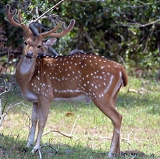
Sri lankan axis deer
Encyclopedia
The Sri Lankan axis deer (Axis axis ceylonensis) or Ceylon Spotted Deer is a subspecies of axis deer (Axis axis) that inhabits only Sri Lanka
. The name chital
is not used in Sri Lanka. Its validity is disputed, and some maintain that the axis deer is monotypic
(i.e., has no subspecies).
Axis deer are important prey for the Sri Lankan leopard
. It is also prey for sloth bear
s and jackal
s.
Very rarely, these deer inhabit dry mountain areas.
Unlike the mainland axis deer (Axis axis) which is plentiful, Sri Lankan axis deer populations
are considered to be vulnerable. Threats include hunting for meat and deforestation. Historically, axis deer were found in very large numbers in the entire dry zone of Sri Lanka, but these numbers have been significantly reduced. Today several thousands of these deer are found in Sri Lanka. Sri Lankan axis deer are mainly found in protected areas in the dry zone, with a small number of herds living outside the protected forest areas. Large herds can be found only in protected areas.
Sri Lanka
Sri Lanka, officially the Democratic Socialist Republic of Sri Lanka is a country off the southern coast of the Indian subcontinent. Known until 1972 as Ceylon , Sri Lanka is an island surrounded by the Indian Ocean, the Gulf of Mannar and the Palk Strait, and lies in the vicinity of India and the...
. The name chital
Chital
The chital or cheetal , also known as chital deer, spotted deer or axis deer is a deer which commonly inhabits wooded regions of Sri Lanka, Nepal, Bangladesh, Bhutan, India, and in small numbers in Pakistan...
is not used in Sri Lanka. Its validity is disputed, and some maintain that the axis deer is monotypic
Monotypic
In biology, a monotypic taxon is a taxonomic group with only one biological type. The term's usage differs slightly between botany and zoology. The term monotypic has a separate use in conservation biology, monotypic habitat, regarding species habitat conversion eliminating biodiversity and...
(i.e., has no subspecies).
Food
Sri Lankan axis deer are active primarily during early morning and again during the evening, but they are commonly observed near waterholes anytime. The Sri Lankan axis deer eats primarily grasses, but it also eats fallen fruits and leaves. The Sri Lankan axis deer graze closely with langur, peacock, wild buffalo, and sambar. They usually lives in groups of between 10-60 animals, though herds may include up to 100 animals.Axis deer are important prey for the Sri Lankan leopard
Leopard
The leopard , Panthera pardus, is a member of the Felidae family and the smallest of the four "big cats" in the genus Panthera, the other three being the tiger, lion, and jaguar. The leopard was once distributed across eastern and southern Asia and Africa, from Siberia to South Africa, but its...
. It is also prey for sloth bear
Sloth Bear
The sloth bear , also known as the labiated bear, is a nocturnal insectivorous species of bear found wild within the Indian subcontinent. The sloth bear evolved from ancestral brown bears during the Pleistocene and shares features found in insect-eating mammals through convergent evolution...
s and jackal
Jackal
Although the word jackal has been historically used to refer to many small- to medium-sized species of the wolf genus of mammals, Canis, today it most properly and commonly refers to three species: the black-backed jackal and the side-striped jackal of sub-Saharan Africa, and the golden jackal of...
s.
Habitat range and conservation status
These deer inhabit lowland dry forests, savannas, and shrub lands.Very rarely, these deer inhabit dry mountain areas.
Unlike the mainland axis deer (Axis axis) which is plentiful, Sri Lankan axis deer populations
are considered to be vulnerable. Threats include hunting for meat and deforestation. Historically, axis deer were found in very large numbers in the entire dry zone of Sri Lanka, but these numbers have been significantly reduced. Today several thousands of these deer are found in Sri Lanka. Sri Lankan axis deer are mainly found in protected areas in the dry zone, with a small number of herds living outside the protected forest areas. Large herds can be found only in protected areas.

